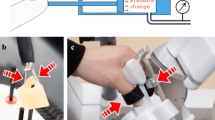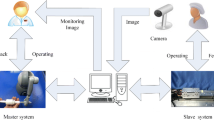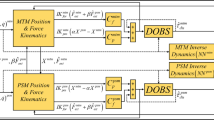Abstract
Natural Orifice Transluminal Endoscopic Surgery (NOTES) involves the surgical treatment of a patient by reaching the location of surgery through the natural orifices of the human body. In the Robotic-NOTES, there is a bilateral teleoperation system between master and slave robots. Here, the Phantom Omni haptic device that gives motion trajectory and gets the force feedback is used as a master. The surgical manipulators, i.e., a miniature robot that follows the trajectory given by the master and interacts with the environment is used as a slave. In this work, firstly, the study of kinematic relation for the tip position and joint angles of the master and slave is carried out. Then the joint angles for a tip position of the slave robot are calculated for the trajectory planning. After that, a virtual environment is created to get the force feedback for the master from the slave while performing tissue manipulation for the virtual stomach model. Force feedback that we get in a virtual haptic environment will help in training a naive surgeon. Variation in the forces applied to the stomach virtual model and the force feedback in the master device is negligible.
Access this chapter
Tax calculation will be finalised at checkout
Purchases are for personal use only
Similar content being viewed by others
References
Taylor RH (2006) A perspective on medical robotics. Proc IEEE 94(9):1652–1664. https://doi.org/10.1109/JPROC.2006.880669
Casals A (1999) Medical robotics at UPC. Microproc Microsys 23(2):69–74 (1999). https://doi.org/10.10007/1234567890
Farghaly SA (2013) Current surgical treatment option, utilizing robotassisted laparoscopic surgery in obese women with endometrial cancer: Farghaly’s technique. J Egypt Nat Cancer Inst 25(2):57–61. https://doi.org/10.1016/j.jnci.2013.03.002
Ballantyne GH (2002) Robotic surgery, telerobotic surgery, telepresence, and telementoring: review of early clinical results. Surg Endosc interv Tech 16(10):1389–1402. https://doi.org/10.1016/j.jnci.2013.03.002
Wang Z, Phee SJ, Wong J, Ho KY (2012) Development of a robotic platform for natural orifice transluminal endoscopic surgery. Gastrointest Interv 1(1):40–42. https://doi.org/10.1016/j.gii.2012.08.010
Sutar MK, Pathak PM, Sharma A, Mehta N, Gupta V (2013) Forward kinematic analysis of in-vivo robot for stomach biopsy. J Rob Surg 7(3):281–287. https://doi.org/10.1007/s11701-012-0375-y
Reiter A, Allen PK (2010) An online learning approach to in-vivo tracking using synergistic features. In: 2010 IEEE/RSJ international conference 2010 intelligent robots and systems (IROS), IEEE (2010), pp 3441–3446. https://doi.org/10.1109/IROS.2010.5650852
Maniya JB, Pathak PM, Mishra BK (2010) Design and development of virtual objects to be used with haptic device for motor rehabilitation. J Softw Eng Appl 3(10):990–997. https://doi.org/10.1109/IROS.2010.5650852
Saini S, Pathak PM, Orlando MF (2019) Bondgraph modelling for the master-slave robotic teleoperation system. In: 2019 28th IEEE international conference on robot and human interactive communication (RO-MAN), New Delhi, India, pp 1–6 (2019). https://doi.org/10.1109/RO-MAN46459.2019.8956409
McDermott SD (1999) A haptic assembly and disassembly simulation environment and associated computational load optimization techniques. J. Comput Inf Sci Eng. 1(1):113–122. https://doi.org/10.1115/1.1389085
Salamanca MLP, Navarro JMS, Esmeral JS (2011) Analysing collision detection in a virtual environment for haptic applications in surgery. Ingeniera e Investigacin 31(1):204–212. https://doi.org/10.1115/1.1389085
Silva AJ, Ramirez OAD, Vega VP, Oliver JPO (2009) Phantom omni haptic device: kinematic and manipulability. In: Electronics, robotics and automotive mechanics conference. IEEE (2009), pp 193–198. https://doi.org/10.1109/CERMA.2009.55
Sansanayuth T, Nilkhamhang I, Tungpimolrat K (2012) Teleoperation with inverse dynamics control for phantom omni haptic device. In: SICE annual conference (SICE), 2012. IEEE, pp 2121–2126
Ahmmad SM, Khan M, Rahman M, Billah M (2013) Position control of a four link hyper redundant robotic manipulator. Asian J Scient Res 6(1):67–77
Craig JJ (2005) Introduction to robotics: mechanics and control. Pearson Prentice Hall Upper Saddle River (2005)
Toolkit O (2005) The SenSable technologies Inc., NJ, USA
Acknowledgements
The financial assistance to Mr. Sarvesh Saini in the form of a Research Fellowship (SRF)(sanction file no. is 09/143(0895)/2017-EMR-I) of the Council of Scientific and Industrial Research (CSIR), New Delhi is greatly acknowledged.
Author information
Authors and Affiliations
Corresponding author
Editor information
Editors and Affiliations
Rights and permissions
Copyright information
© 2022 Springer Nature Singapore Pte Ltd.
About this paper
Cite this paper
Saini, S., Pathak, P.M. (2022). Experimental and Simulation Study of Haptically Enabled Robotic Teleoperation for NOTES. In: Kumar, R., Chauhan, V.S., Talha, M., Pathak, H. (eds) Machines, Mechanism and Robotics. Lecture Notes in Mechanical Engineering. Springer, Singapore. https://doi.org/10.1007/978-981-16-0550-5_106
Download citation
DOI: https://doi.org/10.1007/978-981-16-0550-5_106
Published:
Publisher Name: Springer, Singapore
Print ISBN: 978-981-16-0549-9
Online ISBN: 978-981-16-0550-5
eBook Packages: EngineeringEngineering (R0)




